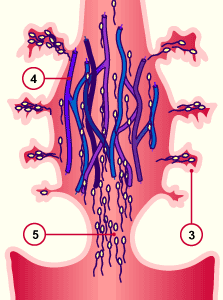
1
2
3
|
Sperm cells
Mucus fibers (strongly meshed)
Crypt of a cervix gland |
|
|
|

4
5 |
Mucus fibers (loosely meshed)
Portio entrance |
|
|
|
Fig. 26; Fig. 27
Before ovulation the cervix canal is narrow, with a few, small cervix glands, and the mucus is highly meshed. The sperm cells "jam up" at the portio entrance.
At ovulation the cervix canal becomes a lot wider, with many, widely branching cervix glands, and the mucus becomes loosely meshed. Passages form therein and the sperm cells are now able to pass through.
|

